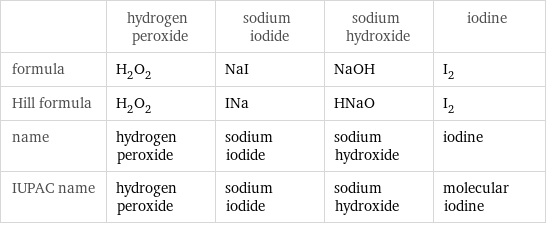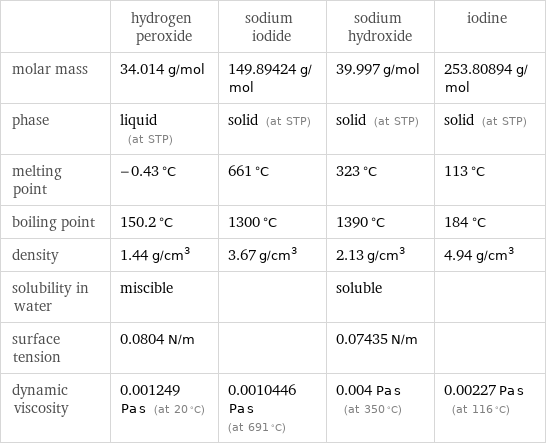Input interpretation

H_2O_2 hydrogen peroxide + NaI sodium iodide ⟶ NaOH sodium hydroxide + I_2 iodine
Balanced equation

Balance the chemical equation algebraically: H_2O_2 + NaI ⟶ NaOH + I_2 Add stoichiometric coefficients, c_i, to the reactants and products: c_1 H_2O_2 + c_2 NaI ⟶ c_3 NaOH + c_4 I_2 Set the number of atoms in the reactants equal to the number of atoms in the products for H, O, I and Na: H: | 2 c_1 = c_3 O: | 2 c_1 = c_3 I: | c_2 = 2 c_4 Na: | c_2 = c_3 Since the coefficients are relative quantities and underdetermined, choose a coefficient to set arbitrarily. To keep the coefficients small, the arbitrary value is ordinarily one. For instance, set c_1 = 1 and solve the system of equations for the remaining coefficients: c_1 = 1 c_2 = 2 c_3 = 2 c_4 = 1 Substitute the coefficients into the chemical reaction to obtain the balanced equation: Answer: | | H_2O_2 + 2 NaI ⟶ 2 NaOH + I_2
Structures

+ ⟶ +
Names

hydrogen peroxide + sodium iodide ⟶ sodium hydroxide + iodine
Reaction thermodynamics
Gibbs free energy

| hydrogen peroxide | sodium iodide | sodium hydroxide | iodine molecular free energy | -120.4 kJ/mol | -286.1 kJ/mol | -379.7 kJ/mol | 0 kJ/mol total free energy | -120.4 kJ/mol | -572.2 kJ/mol | -759.4 kJ/mol | 0 kJ/mol | G_initial = -692.6 kJ/mol | | G_final = -759.4 kJ/mol | ΔG_rxn^0 | -759.4 kJ/mol - -692.6 kJ/mol = -66.8 kJ/mol (exergonic) | | |
Equilibrium constant
![Construct the equilibrium constant, K, expression for: H_2O_2 + NaI ⟶ NaOH + I_2 Plan: • Balance the chemical equation. • Determine the stoichiometric numbers. • Assemble the activity expression for each chemical species. • Use the activity expressions to build the equilibrium constant expression. Write the balanced chemical equation: H_2O_2 + 2 NaI ⟶ 2 NaOH + I_2 Assign stoichiometric numbers, ν_i, using the stoichiometric coefficients, c_i, from the balanced chemical equation in the following manner: ν_i = -c_i for reactants and ν_i = c_i for products: chemical species | c_i | ν_i H_2O_2 | 1 | -1 NaI | 2 | -2 NaOH | 2 | 2 I_2 | 1 | 1 Assemble the activity expressions accounting for the state of matter and ν_i: chemical species | c_i | ν_i | activity expression H_2O_2 | 1 | -1 | ([H2O2])^(-1) NaI | 2 | -2 | ([NaI])^(-2) NaOH | 2 | 2 | ([NaOH])^2 I_2 | 1 | 1 | [I2] The equilibrium constant symbol in the concentration basis is: K_c Mulitply the activity expressions to arrive at the K_c expression: Answer: | | K_c = ([H2O2])^(-1) ([NaI])^(-2) ([NaOH])^2 [I2] = (([NaOH])^2 [I2])/([H2O2] ([NaI])^2)](../image_source/fc2dd87dfad2cc7127192905b870154c.png)
Construct the equilibrium constant, K, expression for: H_2O_2 + NaI ⟶ NaOH + I_2 Plan: • Balance the chemical equation. • Determine the stoichiometric numbers. • Assemble the activity expression for each chemical species. • Use the activity expressions to build the equilibrium constant expression. Write the balanced chemical equation: H_2O_2 + 2 NaI ⟶ 2 NaOH + I_2 Assign stoichiometric numbers, ν_i, using the stoichiometric coefficients, c_i, from the balanced chemical equation in the following manner: ν_i = -c_i for reactants and ν_i = c_i for products: chemical species | c_i | ν_i H_2O_2 | 1 | -1 NaI | 2 | -2 NaOH | 2 | 2 I_2 | 1 | 1 Assemble the activity expressions accounting for the state of matter and ν_i: chemical species | c_i | ν_i | activity expression H_2O_2 | 1 | -1 | ([H2O2])^(-1) NaI | 2 | -2 | ([NaI])^(-2) NaOH | 2 | 2 | ([NaOH])^2 I_2 | 1 | 1 | [I2] The equilibrium constant symbol in the concentration basis is: K_c Mulitply the activity expressions to arrive at the K_c expression: Answer: | | K_c = ([H2O2])^(-1) ([NaI])^(-2) ([NaOH])^2 [I2] = (([NaOH])^2 [I2])/([H2O2] ([NaI])^2)
Rate of reaction
![Construct the rate of reaction expression for: H_2O_2 + NaI ⟶ NaOH + I_2 Plan: • Balance the chemical equation. • Determine the stoichiometric numbers. • Assemble the rate term for each chemical species. • Write the rate of reaction expression. Write the balanced chemical equation: H_2O_2 + 2 NaI ⟶ 2 NaOH + I_2 Assign stoichiometric numbers, ν_i, using the stoichiometric coefficients, c_i, from the balanced chemical equation in the following manner: ν_i = -c_i for reactants and ν_i = c_i for products: chemical species | c_i | ν_i H_2O_2 | 1 | -1 NaI | 2 | -2 NaOH | 2 | 2 I_2 | 1 | 1 The rate term for each chemical species, B_i, is 1/ν_i(Δ[B_i])/(Δt) where [B_i] is the amount concentration and t is time: chemical species | c_i | ν_i | rate term H_2O_2 | 1 | -1 | -(Δ[H2O2])/(Δt) NaI | 2 | -2 | -1/2 (Δ[NaI])/(Δt) NaOH | 2 | 2 | 1/2 (Δ[NaOH])/(Δt) I_2 | 1 | 1 | (Δ[I2])/(Δt) (for infinitesimal rate of change, replace Δ with d) Set the rate terms equal to each other to arrive at the rate expression: Answer: | | rate = -(Δ[H2O2])/(Δt) = -1/2 (Δ[NaI])/(Δt) = 1/2 (Δ[NaOH])/(Δt) = (Δ[I2])/(Δt) (assuming constant volume and no accumulation of intermediates or side products)](../image_source/86d69263fa332570a6bbbc1bba5e84e1.png)
Construct the rate of reaction expression for: H_2O_2 + NaI ⟶ NaOH + I_2 Plan: • Balance the chemical equation. • Determine the stoichiometric numbers. • Assemble the rate term for each chemical species. • Write the rate of reaction expression. Write the balanced chemical equation: H_2O_2 + 2 NaI ⟶ 2 NaOH + I_2 Assign stoichiometric numbers, ν_i, using the stoichiometric coefficients, c_i, from the balanced chemical equation in the following manner: ν_i = -c_i for reactants and ν_i = c_i for products: chemical species | c_i | ν_i H_2O_2 | 1 | -1 NaI | 2 | -2 NaOH | 2 | 2 I_2 | 1 | 1 The rate term for each chemical species, B_i, is 1/ν_i(Δ[B_i])/(Δt) where [B_i] is the amount concentration and t is time: chemical species | c_i | ν_i | rate term H_2O_2 | 1 | -1 | -(Δ[H2O2])/(Δt) NaI | 2 | -2 | -1/2 (Δ[NaI])/(Δt) NaOH | 2 | 2 | 1/2 (Δ[NaOH])/(Δt) I_2 | 1 | 1 | (Δ[I2])/(Δt) (for infinitesimal rate of change, replace Δ with d) Set the rate terms equal to each other to arrive at the rate expression: Answer: | | rate = -(Δ[H2O2])/(Δt) = -1/2 (Δ[NaI])/(Δt) = 1/2 (Δ[NaOH])/(Δt) = (Δ[I2])/(Δt) (assuming constant volume and no accumulation of intermediates or side products)
Chemical names and formulas

| hydrogen peroxide | sodium iodide | sodium hydroxide | iodine formula | H_2O_2 | NaI | NaOH | I_2 Hill formula | H_2O_2 | INa | HNaO | I_2 name | hydrogen peroxide | sodium iodide | sodium hydroxide | iodine IUPAC name | hydrogen peroxide | sodium iodide | sodium hydroxide | molecular iodine
Substance properties

| hydrogen peroxide | sodium iodide | sodium hydroxide | iodine molar mass | 34.014 g/mol | 149.89424 g/mol | 39.997 g/mol | 253.80894 g/mol phase | liquid (at STP) | solid (at STP) | solid (at STP) | solid (at STP) melting point | -0.43 °C | 661 °C | 323 °C | 113 °C boiling point | 150.2 °C | 1300 °C | 1390 °C | 184 °C density | 1.44 g/cm^3 | 3.67 g/cm^3 | 2.13 g/cm^3 | 4.94 g/cm^3 solubility in water | miscible | | soluble | surface tension | 0.0804 N/m | | 0.07435 N/m | dynamic viscosity | 0.001249 Pa s (at 20 °C) | 0.0010446 Pa s (at 691 °C) | 0.004 Pa s (at 350 °C) | 0.00227 Pa s (at 116 °C)
Units
